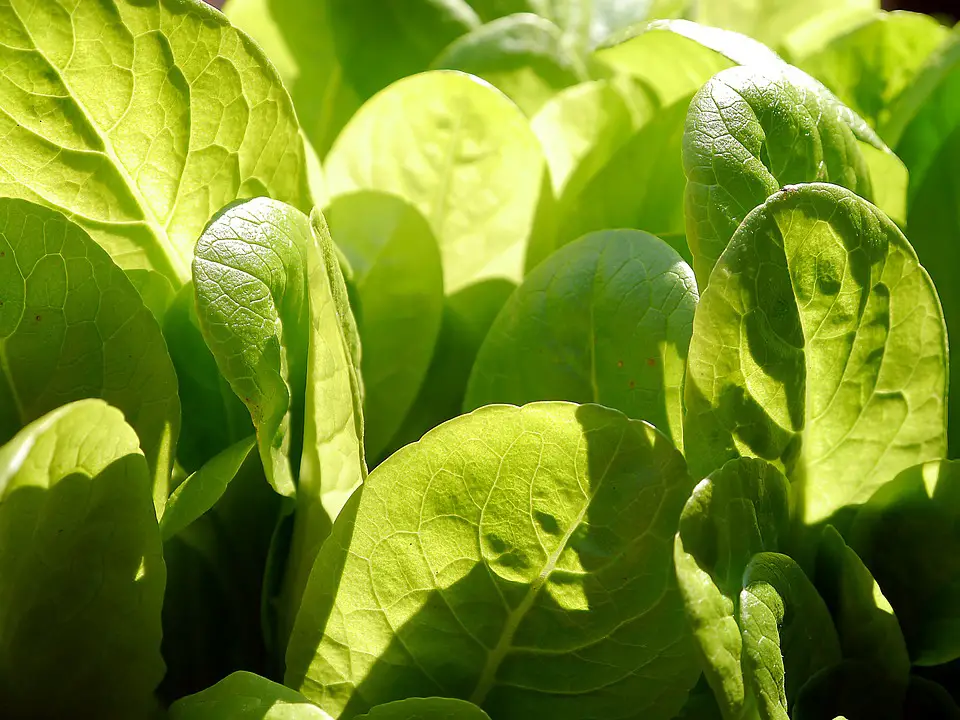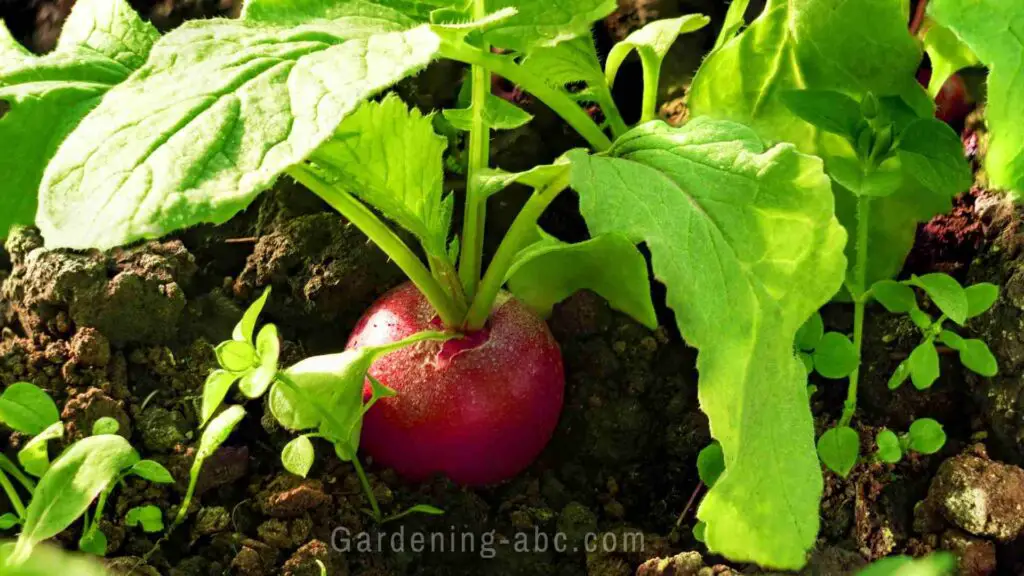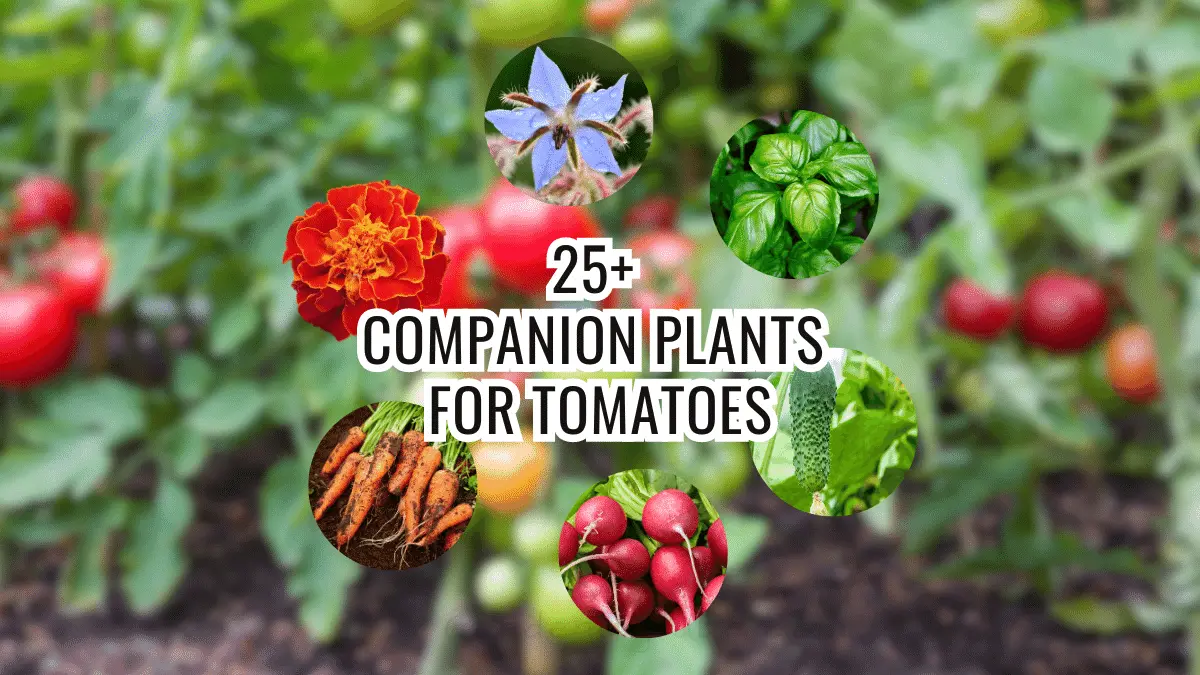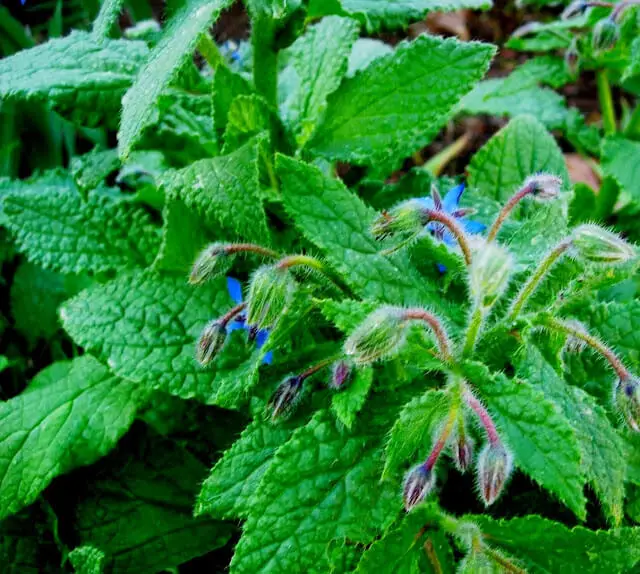We use affiliate links to run our site. When you buy through links on our site, we may earn an affiliate commission, without any added cost to you. Learn more
Hello friends! It’s me again, your friend Prasenjit. I wanted to talk to you today about one of my favorite gardening techniques – companion planting with tomatoes.
Now I know some of you are wondering, what in tarnation is companion planting? Basically, it’s where you plant different crops together so they can help each other out.
The Three Sisters method we came up with is a great example, where corn, beans, and squash are grown together. But today I want to focus on some of the best buddies you can pair with tomatoes specifically.
Growing up, my mother taught me all sorts of secrets for growing a bountiful garden. Through seasons of trial and error, we learned firsthand how some plants just seem to thrive when they’re paired next to certain others.
The harmony between the plants benefits the soil, deters garden pests, and gives you a darn good harvest. Companion planting is a wonderful way to work with Mother Nature’s blessings instead of against them.
Let me tell you, finding the right companion plants for tomatoes can make a world of difference. Those juicy red beauties can be kinda delicate, so surrounding them with the right friends enhances their health and flavor.
Trust me, the tomatoes get tastier, the bugs stay away, and you don’t have to work as hard – it’s a win-win!
Why use companion plants?
Now I bet you’re wondering, what exactly are the benefits of companion planting? I’m fixin’ to tell ya!
First off, certain plants can actually repel or confuse those bothersome insects that like to chew holes in your tomato leaves. Some companions have strong scents that essentially drive away pests or mask the smell of your tomato plants.
Others attract beneficial critters like ladybugs that eat the bad bugs. Either way, companion planting helps protect your crop.
In addition to pest control, neighboring plants help boost pollination, too. More pollination means more tomatoes! Flowers interplanted with your tomatoes attract pollinators like bees and butterflies. And we all know more bees mean happier plants.
Another perk is that some companions improve the flavor of your tomatoes by releasing compounds into the soil that get absorbed by the tomato plant’s roots. It’s like a secret seasoning Mother Nature provides – I call it garden magic!
Certain companion plants also help fertilize the soil, provide ground cover to retain moisture, and some even repel weeds. Plus, it’s an efficient use of garden space when you can grow two or more crops in the same area.
Long story short, companion planting makes growing tomatoes easier with fewer problems. And who couldn’t use a little more tomato bounty with less hassle? Not this girl!
Now, let’s get into the nitty gritty – here are some of my favorite companion plants for tomatoes and why I recommend them:
Tomato Companion Plants to Repel Harmful Insects
Let’s start with some companions that can help ward off pests that love to wreak havoc on tomatoes.
Marigolds:

These bright, cheery flowers contain terpenes that confuse and repel so many common tomato bugs – nematodes, beetles, aphids, whiteflies…the list goes on! Their strong scent helps mask and protect tomato plants. Marigolds are easy to grow from seed and make a beautiful border surrounding your vegetables.
Basil:
Mmm, just thinking about the smell of basil makes me hungry for some fresh bruschetta! Besides being delicious, basil deters thrips, flies, mosquitoes, and aphids from landing on your tomatoes. As a bonus, it enhances tomato flavor and growth. Keeping a few basil plants near your tomatoes is a no-brainer.
Petunias:
How pretty are petunias with their trumpet-shaped blooms? Well, they happen to repel lots of tomato-loving insects like aphids, tomato hornworms, and asparagus beetles.
Their strong fragrance confuses pests and minimizes damage to your tomato crop. Petunias are easy to care for and bring some vibrant color around your vegetables.
Garlic:
Yep, even humble garlic makes a great companion for tomatoes! It deters aphids, spider mites, cabbage loopers, and other creepy crawlers. Plus, garlic helps protect tomato plants from disease.
As a bonus, you can use the garlic cloves from the plant in your cooking. It’s a win-win.
Chives:
With their grassy stalks and purple pom pom flowers, chives add beauty while also driving away aphids from your tomatoes. Their allium scent repels those pesky insects. As a bonus, you can snip chives to use in recipes or garnish dishes. They come back year after year, too!
Tomato Companion Plants to Increase Beneficial Insects
In addition to driving away pests, some smart companion plants actually attract helpful critters to your garden. These beneficial insects prey on harmful bugs, protecting your tomatoes in the process.
Marigolds:
Cute little marigolds pull double duty by also luring in “good bugs” like hoverflies and lacewings that munch on aphids and other pests. More marigolds mean fewer bad bugs on your tomatoes!
Cosmos:
With airy, delicate flowers in lovely colors, cosmos are a gorgeous addition to your tomato garden. As an added bonus, they attract parasitic wasps, tachinid flies, and hoverflies, which prey on common tomato pests.
Bachelor Buttons:
Also called cornflowers, these annuals have such unique, vivid blooms that brighten up your garden beautifully. Bachelor buttons also lure in helpful insects like tachinid flies and hoverflies that control tomato-loving bugs.
Queen Anne’s Lace:
This graceful wildflower with its umbrella-shaped white blooms attracts predatory wasps, which feast on aphids, caterpillars, and other pests that can damage tomato plants. Plus, Queen Anne’s lace crowds out weeds.
Dandelions:
I know some folks see these yellow flowers as pesky weeds, but dandelions attract so many beneficial insects like ladybugs, hoverflies, and lacewings that prey on common tomato pests. Let some dandelions grow near your tomatoes and appreciate their value!
Tomato Companion Plants for Weed Control
If weeds are the bane of your garden, here are some good companion plants that help control them around tomato plants:
Buckwheat:
This easy-cover crop crowds out weeds well, allowing your tomato plants the space, nutrients, and sunlight they need. Once buckwheat flowers, it also brings in beneficial pollinators before you till it under.
Rye:
The fast-growing and hardy grain rye makes a useful cover crop around tomato plants. It prevents light from reaching weed seeds and smothers out existing weeds, too. Rye adds organic matter back into the soil as you till it under.
Barley:
Another cover crop option is barley, which forms a thick canopy that deprives weeds of sunlight and resources. The extensive root system of barley also helps aerate and enrich the soil for better drainage and nutrient uptake by tomato plants.
Crimson Clover:
This striking red and white flowering cover crop not only prevents weed growth near tomatoes but also fixes nitrogen from the air into the soil. Once tilled under, the nitrogen from clover becomes available for tomato plants. It’s a fertilizer and weed control in one!
Tomato Companion Plants to Increase Pollination
Nothing beats pollination for producing plump, abundant tomatoes! Here are some ideal companions that attract pollinators like bees and butterflies:
Borage:
With its edible star-shaped flowers, borage attracts tons of bees when planted among tomatoes. More bees equal better pollination and a bumper tomato crop. As a bonus, borage leaves have a cucumber-like flavor perfect for drinks or salads!
Cosmos:
In addition to attracting beneficial insects, pretty cosmos also lure in pollinators like bees and butterflies. Plant cosmos around the border of your tomato patch for maximum pollination. These daisy-like annuals bloom all summer and self-sow for the next year.
Marigolds:
You’ll get a double-whammy of pest control and pollination from vibrant marigolds around your tomatoes. Marigolds attract hoverflies as well as honeybees for better pollination. Plus, they come in a rainbow of colors to brighten your garden.
Zinnias:
Few flowers attract pollinators quite like zinnias! Planting a variety near your tomatoes brings in bees, butterflies, and hummingbirds, ensuring your tomatoes get well-pollinated. Zinnias are easy to grow from seed and provide color in the garden all season long.
Sunflowers:
Towering sunflowers always turn their brilliant yellow heads to the sun, making them cheery garden companions for tomatoes. They also provide lots of pollen for bees and other pollinators. Try planting dwarf varieties so they don’t shade tomato plants.
Tomato Companion Plants to Improve Tomato Health
There are also some companions that directly improve tomato plant vigor and health:
Basil
Is there anything Basil can’t do? In addition to repelling pests, basil actually enhances the growth and flavor of tomatoes planted nearby. These two classics from the Mediterranean region are perfect partners in your garden patch!
Parsley
The bright green beauty of parsley isn’t just a pretty garnish, it also boosts the health of its tomato neighbors. Parsley improves the vigor and flavor of tomato plants growing close by while attracting helpful pollinators too.
Carrots
Something as simple as planting carrots near tomatoes can be beneficial. As carrots grow and loosen the soil, they aerate and improve drainage for tomato roots. This helps prevent disease and nutrient deficiencies in tomatoes.
Cucumbers
While cucumbers and tomatoes hail from the same plant family, they actually make great companions. Cucumbers regulate moisture in the soil and shade hot summer soil, benefiting tomatoes. Just be sure to provide cucumber trellises so they don’t spread.
Celery
That crunchy, savory stalk improves the flavor of homegrown tomatoes planted in nearby proximity. Like carrots, celery also helps aerate and loosen the soil to benefit tomato root health and drainage.
Best Plants to Grow in Containers with Tomatoes
For my gardening friends with limited space, certain compact companions are perfect for planting in patio containers alongside tomatoes. Here are some top suggestions:
Lettuce:

Leaf lettuces like oakleaf and romaine thrive in part shade under tomato plants. They’ll fill out the container while benefiting from the shade as summer heats up. Snip lettuce leaves all season for salads to pair with those homegrown tomatoes!
Bush Beans:
Compact bush bean varieties fit nicely into containers with tomatoes. Beans provide nitrogen in the soil that tomatoes can use. Stagger planting times so beans mature before the tomato vines take over the entire container space.
Radishes:

Quick-growing radishes mature in just a month, so they’re a perfect companion for tomatoes in containers. Their spicy crunch complements juicy tomatoes! Be sure to harvest promptly once radishes size up to make room for your tomatoes.
Petunias:
As mentioned earlier, pest-repelling petunias make a pretty companion for container tomatoes. Choose low-growing, spreading varieties in bright colors. Petunias bloom continuously when deadheaded and don’t require much care.
Sweet Alyssum:
With its sweet, honey-like fragrance and carpet of tiny blossoms, sweet alyssum makes a dreamy companion to tomatoes on your patio. They attract beneficial insects while trailing gracefully around the edges of your container garden.
Final Thoughts:
Whew, that was a lot of information! I know it can seem tricky or overwhelming at first, but give companion planting a try, and I guarantee you’ll be amazed by the results. Pay attention to how your plants interact, and each year your garden wisdom will grow.
The most important thing is to have fun with it and go with the flow! Don’t stress about finding every “perfect” pairing. Just look for opportunities to interplant tomatoes with beneficial friends. Your tomatoes will thank you with bountiful harvests, fewer pests, and delicious flavor.
Companion planting lets you work in harmony with nature – and that’s what gardening is all about! Let me know how your tomato companion planting goes or if you have any other questions. Happy growing my friends!
Frequently Asked Questions (FAQs):
Which flowers make the best companions for tomatoes?
Some of the best flowering companion plants for tomatoes include marigolds, petunias, cosmos, zinnias, nasturtiums, calendula, bachelor buttons, and sunflowers. They attract pollinators, repel pests, and sometimes improve tomato health and flavor through symbiotic root interactions.
How close together should I plant tomato companion plants?
As a general rule, plant smaller companion plants 6-12 inches away from tomato plants. Allow 18-24 inches between tomatoes and larger companion plants like pole beans and cucumbers. Always check the recommended spacing for specific varieties you are planting together.
How often should I rotate tomato companion plants each year?
Rotating tomato companion plants yearly is a good practice to replenish soil nutrients, disrupt pest cycles, and help manage diseases. Try not to plant tomatoes and their companions in the same location for more than 2-3 years in a row. Move the whole grouping together to a new area of the garden each season for the best results.
Do tomatoes and potatoes make good companion plants?
No, tomatoes and potatoes should not be planted together. Both are in the nightshade family and are susceptible to early and late blight fungal diseases. Planting them together increases the chances of a fast-spreading blight infection that can quickly kill both crops. Keep them separated.
Can I grow companion plants in containers or grow bags with tomatoes?
Yes, but be mindful of space. In large containers (like 20-gallon bags), you can pair a tomato with basil or marigold. Trim back plants if they get too big, and ensure each plant has enough room for healthy root development.
What companion plants work well with tomatoes in containers?
For containers, choose compact, small-statured companion plants like bush beans, lettuces, radishes, beets, basil, petunias, marigolds, nasturtiums, and spinach. Make sure companion plants have similar soil needs to tomatoes. Fast-growing companions help maximize space while larger tomatoes establish.
Are there any plants I should avoid planting near tomatoes?
Yes, avoid planting tomatoes near:
Brassicas (like cabbage, broccoli, and cauliflower): Compete for nutrients and may stunt growth.
Corn: Both attract similar pests, like the tomato fruit worm/corn earworm.
Potatoes: Increase the risk of blight.
Fennel: Inhibits tomato growth.
Can I plant multiple companion plants together with tomatoes?
Yes, but avoid overcrowding. Mix and match compatible companions, ensuring each has enough space and sunlight. For example, basil and marigold can share space with a tomato, but monitor growth and prune as needed.
Amazon and the Amazon logo are trademarks of Amazon.com, Inc, or its affiliates.


